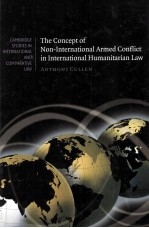

THE CONCEPT OF NON INTERNATIONAL ARMED CONFLICT IN INTERNATIONAL HUMANIARIAN LAWPDF电子书下载
- 电子书积分:10 积分如何计算积分?
- 作 者:ANTHONY CULIEN
- 出 版 社:CAMBRIDGE
- 出版年份:2010
- ISBN:0521760488
- 页数:224 页
Introduction 5
PART Ⅰ Origins of the non-international armed conflict concept and its development in international humanitarian law 5
The application of international humanitarian norms to internal conflict prior to the Geneva Conventions of 1949 7
1.1 The practice of recognition and the application of humanitarian norms in traditional international law 7
1.2 The non-application of the laws of war to situations of rebellion 8
1.3 The concept of insurgency 10
1.4 The recognition of belligerency and the application of international humanitarian norms in civil war 14
1.4.1 The practice of belligerent recognition 14
1.4.2 The legal personality of belligerents in civil war 18
1.4.3 Conditions determining belligerent recognition 19
1.4.4 Problems in the interpretation of belligerency 20
1.4.5 The substitution of 'armed conflict' for 'war' 21
1.4.6 The decline of belligerency as a doctrine of international law 22
1.5 Concluding observations 23
2 Article 3 common to the four Geneva Conventions of 1949 and the threshold of non-international armed conflict in international humanitarian law 25
2.1 The drafting history of common Article 3 27
2.1.1 Interpretation of 'armed conflict not of an international character' at the Geneva Conference of 1949 29
2.1.2 Report of the Joint Committee to the Plenary Assembly of the Diplomatic Conference 42
2.1.3 Plenary debate on the application of the Conventions to armed conflicts not of an international character 44
2.1.4 Comments on the intended scope of common Article 3 49
2.2 The ICRC Commentary on common Article 3 51
2.3 State practice relating to the applicability of common Article 3 55
2.4 Concluding observations 59
3 Changes in the scope of non-international armed conflict resulting from the Additional Protocols of 1977 62
3.1 Additional Protocol I 63
3.1.1 The drafting history of Article 1(4) 66
3.1.2 The customary status of wars of national liberation 81
3.1.3 The applicability of Article 1(4) 83
3.2 Additional Protocol II 86
3.2.1 The drafting history of Additional Protocol II 88
3.2.2 The threshold for the application of Additional Protocol II 102
3.2.3 Applicability of Additional Protocol II 109
3.3 Concluding observations 113
PART Ⅱ The anatomy of non-international armed in international humanitarian law 115
4 The threshold of non-international armed conflict 117
4.1 Tadic: a formula for the characterisation of armed conflict 117
4.1.1 Two aspects of non-international armed conflict determining the applicability of international humanitarian law: the organisation of insurgents and the intensity of hostilities 122
4.1.2 Application of the Tadic formula for the characterisation of armed conflict 133
4.2 The geographical scope of non-international armed conflict 140
4.3 The temporal scope of non-international armed conflict 142
4.4 The existence of armed conflict between non-state actors 146
4.5 The question of responsible command 148
4.5.1 Does the concept of non-international armed conflict presuppose the existence of responsible command? 148
4.5.2 The existence of responsible command as a condition for the characterisation of armed conflict:& Prosecutor v. Hadzihasanovic 150
4.5.3 Responsible command as a condition for the characterisation of non-international armed conflict in international humanitarian law 155
4.6 Concluding observations 157
5 The concept of non-international armed conflict in the Rome Statute of the International Criminal Court 159
5.1 The question of subject-matter jurisdiction over war crimes in non-international armed conflicts prior to the Rome Conference 160
5.2 The question of subject-matter jurisdiction over war crimes in non-international armed conflicts at the Rome Conference 163
5.2.1 Report of the Preparatory Committee on the Establishment of an International Criminal Court 163
5.2.2 Views of delegations on inclusion of clauses relating to non-international armed conflict 165
5.2.3 Bridging the gap: proposals for a threshold for non-international armed conflict 167
5.3 Interpreting the threshold contained in Article 8(2)(f) 174
5.3.1 The meaning of the threshold intended by the Rome Conference 175
5.3.2 Textual interpretation of Article 8(2)(f) 177
5.3.3 The customary status of provisions relating to non-international armed conflict and the interpretation of the threshold contained in Article 8(2)(f) 183
5.4 Concluding observations 185
6 Conclusion 186
6.1 On the interpretation of non-international armed conflict 189
6.2 On the significance of the Tadic definition 190
6.3 The characterisation of non-international armed conflict and its effect on the legal status of parties 192
Bibliography 194
Index 212
- 《哈里森内科学 第19版 双语版 上》(美)丹尼斯·L.卡斯帕(Dennis L. Kasper),(美)安东尼·S.福奇由(Anthony S.Fauci),(美)斯蒂芬·L.豪泽(Stephen L.Hauser)著;王海译 2019
- 《DISORDERS OF THE SHOULDER DIAGNOSIS AND MANAGEMENT:SPORTS INJURIES THIRD EDITION VULUME 2》ANTHONY MINIACI 2014
- 《相信吉宁斯》(英)安东尼·巴克里奇(Anthony Buckeridge)著;刁克利译 1969
- 《会计学基础 原书第11版》(加)莱斯利K·布莱特纳(LeslieK·Breitner)(美)罗伯特N·安东尼(RobertN·Anthony)著 2014
- 《末世协奏曲》乔艾拉·安东尼(Joelle Anthony);章晋唯译 2012
- 《A Practical Course for English Language Teachers》魏立明,戴丽红,Anthony Joserph Droege III著 2005
- 《荣誉法则》(美) 克瓦米·安东尼·阿皮亚 (Kwame Anthony Appiah)著;庄安祺译 2012
- 《会计学基础》(美)莱斯利·K. 布莱特纳(Leslie K. Breitner),罗伯特·N. 安东尼(Robert N. Anthony)著 2013
- 《性趣》安东尼·哈里斯(Anthony.Harris)著;陈苍多译 1999
- 《一分钟智慧》安东尼·德梅罗(Anthony de Mello)著;陈苍多译 1998
